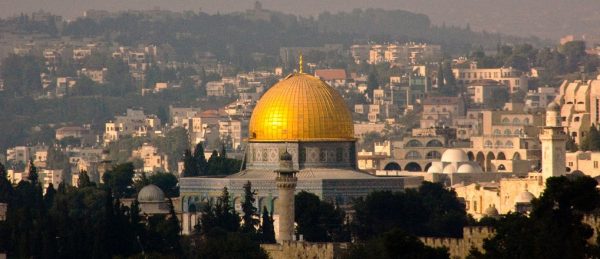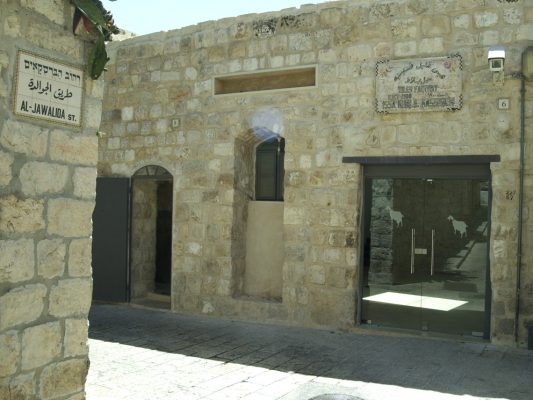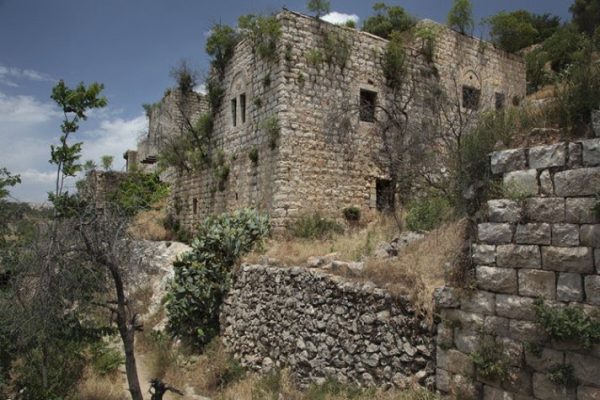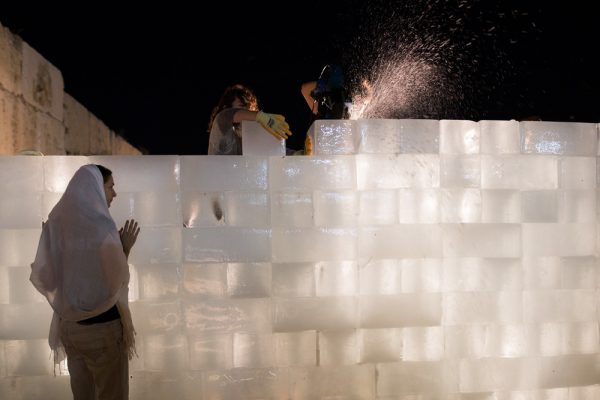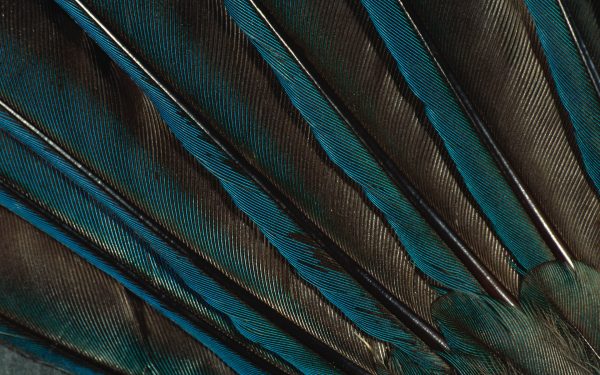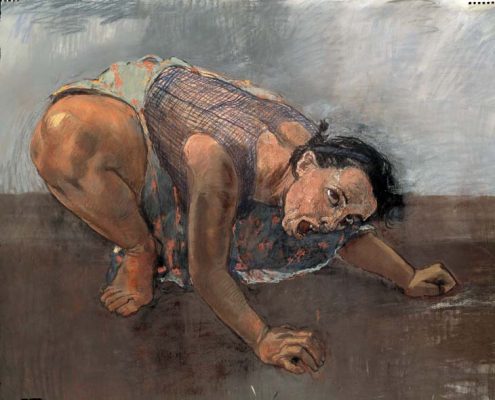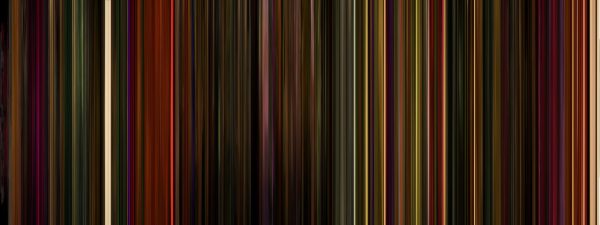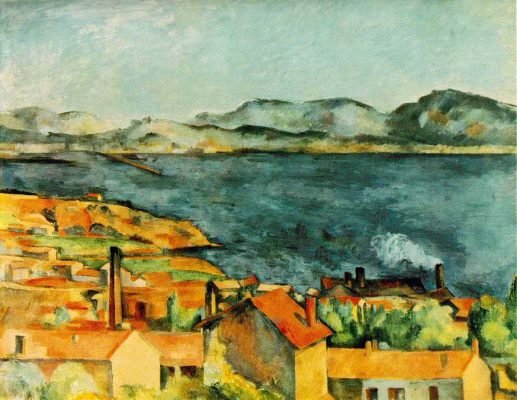Jerusalem has a remarkably cohesive identity, in architectural terms. Every building, from the Western Wall to the sleek hotels and high-rises in the newer parts of town, is constructed of the same sandy-coloured limestone, a measure put in place by British authorities who governed between 1917 and 1947. This surface uniformity connects Jerusalem with the wider Jewish landscape, across time and space: ‘Jerusalem stone’ has been a feature of the city’s architecture since ancient times, when residents collected blocks from the local quarry (now a bustling station) to build their homes, and it is used in buildings worldwide to symbolise connection with the holy city. In 2010, a Brazilian Pentecostal church signed a reported £8 million contract with Israel, enabling them to import enough Jerusalem stone to build a $300 million, 55-metre-high replica of Solomon’s Temple – complete with olive groves, Ark of the Covenant and helicopter landing pad – in São Paulo.
But the lights and sounds of Jerusalem’s streets tell a different story, one of conflict and contradictions. At night, the tips of mosque minarets glow green against the neon lights of the city’s modern hubs, while muezzins compete not only with church bells but with busy traffic. At the Western Wall, the plaza of prayer is split by a dividing wall which segregates the sexes, though tourists and worshippers are left to mingle. On the women’s side, a bored sweeper patrols while tourists take selfies beside a woman in a headscarf, who mutters devoutly and touches the wall in reverence; nearby stands an incongruous lectern, hosting prayer books in all languages and a discarded plastic glass, half full of warm Coke. Jerusalem’s Old City – just one square kilometre, with over 400 surveillance cameras crammed into crevices in the stone – is divided into Jewish, Muslim, Christian and Armenian quarters, pockets which define themselves both within and against the rest of the city.
The differences between sectors are barely perceptible to outsiders: across the Old City, streets are flanked with marketstalls selling ubiquitous slogan T-shirts and babygros, where ‘Free Palestine’ hangs next to ‘SuperJew’, ‘Hello Jerusalem’ next to ‘Hello Kitty’. But one is quickly reminded that this peaceful, irreverent co-existence is illusory. As I stroll atop the ancient ramparts, gazing over the skyline of washing lines, satellite discs and spires, a soldier, lounging in the shade on his iPhone, nonchalantly moves his gun out of the way to let me pass. Tensions abound at the Church of the Holy Sepulchre in the centre of the Christian quarter (where Jesus’s Empty Tomb stands, encased in police hoarding): the ground is Greek Orthodox, but the steps Armenian, and factions fight over the right to clean the sacred territory. To make everyday life tenable, the keys to the church are in the possession of a Muslim family, while a position on the Israeli government is devoted to the church. It’s a common saying in Jerusalem that when the problems of the Church of the Holy Sepulchre are solved, the problems of the Mediterranean will be solved too.
*
I visited Jerusalem in July to attend the fifth Jerusalem Season of Culture, an annual arts festival which aims to celebrate Jerusalem’s diversity, tell unexpected stories and reconfigure contentious places in the most sacred of cities as sites of constructive, creative dialogue – an undertaking fraught with complexity, when the city’s very identity is at the heart of a geopolitical conflict. By organising events of which many took place within individual homes, predicated on personal reactions to the city and to the performances, the organisers strove to provide space for nuanced exploration of the concept of ‘home’ while remaining aware that, as a privileged section of Jerusalem’s populace, even the most well-intentioned of their ideas may erase the experiences of oppressed minorities within the same city. The festival was initiated by the Charles and Lynn Schusterman Family Foundation, a US-based philanthropic organisation which seeks to empower young Jewish people to connect with Israel and ‘create positive change for themselves, the Jewish community and the broader world’. One might therefore expect the festival to use art as a propaganda tool, for political expedience; I found that it was much more complex – and interesting – than this. The organisers, for the most part, are members of Jerusalem’s secular Jewish community: most expressed pride in their Israeli heritage, yet do not necessarily identify with – and may well deplore – the actions of their government. In the security queue at Luton Airport, I met a woman travelling to Israel with her teenage daughter, who was tortoise-like beneath a giant backpack and off to join a kibbutz. ‘If you think Israel likes going to war,’ she sighed, ‘just look at any Israeli mother whose children are fighting.’
Last year’s Jerusalem Season of Culture was scheduled to begin on 9 July 2014. On 8 July, Operation Protective Edge was launched in the Gaza Strip. Seven weeks of fighting – Israeli bombardment of the West Bank; Palestinian rocket attacks; ground combat – left over 2,100 people, mostly Palestinians, dead. Israel claimed that Gazan rocket fire into the country had increased, while Hamas urged the world to pressure Israel into lifting the blockade of the Gaza Strip. Some of the artists and musicians booked to perform in the festival were instead enlisted, and the organisers decided to cancel. ‘We wouldn’t’, director Naomi Fortis told me, ‘play at festivals while such a violent war is going on.’ It became instead a ‘festival on paper’, symbolic of the unrealised potential of the lives lost at war. The organisers conceived a radio station, which broadcast daily from ‘outsider’ sites around the city, including a former leper hospital: its aim was to contradict those who felt silence was an acceptable response to the suffering being inflicted so close to home. The season’s finale is traditionally a Sacred Music Festival; a ceasefire was announced twelve days before the first concert was scheduled, and the organisers decided to go ahead. It sold out. A Muslim Imam sang with a Jewish rabbi during a Sufi ceremony, shifting between Hebrew and Arabic; people from Jerusalem and elsewhere joined together in the world’s religious capital to affirm their common humanity. ‘We had a festival,’ said Naomi, ‘which was really a healing process – to cry, to mourn, to get together, to express yourself, even start to be happy.’
*
Much of Jerusalem’s land belongs to different countries: the Notre Dame (a magnificent cathedral) is officially Vatican territory, while Mount Scopos, in the city’s northeast, is home to a British Second World War cemetery; between 1948 and 1967, the mountain remained a UN-protected exclave of Israel while its surroundings belonged to Jordan. Even within the broadest identity-groupings within the city, there are kaleidoscopic variations. One third of Jerusalem’s residents are Palestinian, mostly Muslim, but the Muslim quarter of the Old City also encompasses an Afghan quarter and a gypsy quarter. Another third are Ultra-Orthodox Jewish, of whom many speak exclusively Yiddish, meaning they do not share a language with the city’s secular Jewish community. These differences are encoded in the rules of language, behaviour, dress, the daily performances which constitute self-definition. One jolly tailor makes clothes for all the city’s religions in his Old City workshop – in a place where identity signals everything, he told me, civilian dress is as coded as official uniform.
At the end of the Via Dolorosa – the route, it’s said, that Jesus took to his crucifixion – stands Temple Mount, focal point of the city’s tensions. All sides agree on its sanctity – there, the prophet Muhammad is said to have leapt over the Dome of the Rock for a nocturnal meeting with God; there stood the Jewish Second Temple, destroyed by the Romans in AD70 and replaced with a shrine to Jupiter, while Christians believe Mary brought Jesus to the mount as a baby – but no-one can agree on how the space should be used now. It’s administered by a Jordanian entity, the Waqf, and only Muslims are allowed into the Dome itself; non-Muslims are forbidden from praying or carrying any religious objects on the Mount. This, unsurprisingly, is a source of bitterness: on the day I arrived in Jerusalem, police stormed the dome because some Muslims were said to be throwing stones down on to the Jews praying at the Western Wall below. Tourists may visit the complex, but Jews are confined to the Western Wall: a sign at the entrance (entitled ‘Announcement and Warning’) declares that the Chief Rabbinate has decreed that the Mount is so sacred that the rabbis cannot purify people enough to go in. (This is, however, a somewhat post-factum measure: they’re not allowed in anyway.) This Ramadan, 350,000 Muslims crowded onto Temple Mount; a one-way system had to be introduced so they didn’t collide with Jews heading to the wall to pray on Shabbat.
Conflict is inherent within the very architecture on the Mount: the mosque that stands opposite the turquoise and golden Dome was built by Crusaders, who captured Jerusalem in 1099 and turned the dome into a church, the mosque into the palace of the Crusader king. The area is a physical palimpsest of history and strife: in the 1990s Muslims constructed a new, underground prayer space there, the largest built mosque in the world. They threw away the rubbish they uncovered in the demolition – until Jews, taking this as a systematic affront on Jewish history, rescued it and discovered an eclectic archaeological trove, its spoils including Babylonian arrows, coins and a button from one of Napoleon’s soldiers. Muslims, in turn, took this as an elaborate ploy to halt the construction of the mosque so the Jews could claim the space to build a third temple. The morning I visited was, despite the lurking presence of armed guards, at first quiet. Cats squalled as children dashed around the open space playing football, and small groups of Muslims sat in circles with prayer books. It took only a moment for the peace to break. A group of religious Jews, flanked by armed police, strode around the edge of the temple complex, defiantly claiming their territory. Immediately, a gang of jeering children and women in hijabs rushed past and blocked their path with a barricade of wheelie bins, which the police kicked aside; the Jews passed on, pursued by resounding shouts from a nearby group of Muslim men, previously in silent prayer. One of them spotted our group, and started shouting at us: ‘America is giving weapons to the Jews and creating problems all over the world.’ The Muslim women are known as the Murabitat (guardians), and used to be bussed in from nearby towns and given monthly salaries to act against what is seen from their side as a provocative Jewish presence on the mount, an indication of increased Israeli control. By the time I visited, it was done on a volunteer basis, a job entailing a mix of religious practice and political activism: a performance of provocation and resistance. On September 8, Israel’s defence minister declared the group illegal. ‘You see,’ shrugged our guide, ‘history, religion, current events are all the same thing.’
*
Ten years ago, Jerusalem was in the grip of a cultural exodus. Creative types were leaving the city in droves, Palestinians to Ramallah, Israelis to trendy Tel Aviv. The Wake Up Jerusalemites party – a force for pluralism in municipal politics – undertook a piece of performance art which staged a procession of cars driving out of Jerusalem towards Tel Aviv. For Karen, one of the founders of the Season of Culture, Jerusalem is a laboratory for Israeli society, especially in relation to Palestine: it is a microcosm of all the country’s problems, and as such must be the locus of attempts at finding solutions to the current conflict. At the time of this exodus, Israeli philanthropist Lynn Schusterman began to investigate how philanthropy can best have an impact on a city, and the research she commissioned showed that arts and culture was the area where private investment can genuinely shift trends. Thus the annual festival was born.
‘There is no mainstream here,’ Naomi told me, ‘because no one can agree on anything. All is alternative.’ Jerusalem is a city of myriad narratives, voices struggling to be heard, where the privileging of one over any other is an act of political silencing. Artistic collaboration between Israelis and Palestinians is extremely rare: due to the ongoing cultural boycott of Israel, few Palestinians will perform at or attend Israeli-organised events, and Palestinian magazines won’t take advertising for this festival. Edward Said and Daniel Barenboim’s West-Eastern Divan Orchestra, founded in 1999 and including young musicians from throughout the Middle East, is a high-profile example of art being used as a political leveller, Israeli and Palestinian in literal harmony, sharing a platform and working together in a universal language. ‘Divan’ means ‘other’, and the orchestra uses music to promote understanding and communication between the two sides (Barenboim is the first Israeli to hold dual Israeli-Palestinian citizenship). But the Season of Culture organisers are sensitive to the fact that such collaborations, even when they come off, can serve as a false normalisation of the situation: performing harmony and goodwill in a comfortable space undermines and ignores the destruction of Palestinian homes, the expulsion of Palestinians from Jerusalem, the 440km cement wall marked by 522 military checkpoints that segregates the West Bank, the thousands of lives lost. Yet all groups are central to the fabric of the city they share, their mutual home, even when the term ‘home’ is so deeply contested. In a previous Sacred Music festival, an illicit collaboration emphasised just this: a performance of Jewish music was timed to stop just as the muezzins, across the city, began their own haunting call.
*
Al Ma’mal is a Palestinian art foundation in the Arab quarter of the Old City (one of two Palestinian galleries in Jerusalem). Established in 1998 as a continuation of the work done by Anadiel Gallery, the first and only independent gallery in Palestine, it is now housed in a former tile factory (its name means ‘small workshop’), where the downstairs studio is lined with art books – monographs on Doug Aitken, William Kentridge, Louise Bourgeois, Jeff Wall. Beneath a section of glass on the floor is an ancient well, uncovered in 2013 when the space was converted into a gallery: in Jerusalem, history is layered beneath every surface. Hosting international and Palestinian artists (most of whom train abroad) on regular residency programmes, the non-profit gallery doesn’t make commercial sales, nor does it accept any Israeli funding.
Home, distance, cultural belonging and alienation are fertile themes for contemporary Palestinian artists. Turner Prize-shortlisted Mona Hatoum, whose work explores questions of family, womanhood and displacement both cultural and personal, created for the Anadiel Gallery a map of the territories supposed to be returned under the 1993 Oslo Peace Accords to Palestinian control, through blocks of Palestinian olive-oil soap, traditionally made in Nablus. In a 2002 residency at the gallery, Emily Jacir – a Palestinian-American artist – used her American passport to travel across Palestine on behalf of those who are forbidden to visit it, carrying out their requests – ‘Go to Haifa and play soccer with the first Palestinian boy you see on the street’; ‘Drink the water in my parents’ village’ – documenting her movements in an installation called Where We Come From/(Im)mobility. Earlier this year Larissa Sansour – whose work often creates fictionalised spaces with which to subvert geopolitical realities – showed Nation Estate, a satirical film imagining a future Palestinian state as a high rise facing Temple Mount with Bethlehem and Jerusalem on separate floors. As we left the gallery, the curator hugged our Israeli guide Tamar, and told her she hoped to attend some of the Season of Culture events. But as part of the cultural boycott, the gallery refuses any collaboration with Israeli artists: friendships such as theirs must remain unofficial. Walking back through the Old City, dodging impatient boy couriers hauling trolleys down the stone steps, Tamar shrugged her shoulders sadly. ‘We could do beautiful things together,’ she said. ‘But I don’t think it will happen in my lifetime.’
In 1947, the state of Israel’s founders accepted a UN proposal to create two separate states and partition Jerusalem into Arab and Israeli sectors. Now, an unassuming highway – trams whizzing through – marks the Seamline, previously no man’s land between Israel (West Jerusalem) and Jordan (East). There stands the Museum on the Seam, a ‘socio-political contemporary art museum’ (nothing in Jerusalem is straightforward) in a former army border outpost, where remnants of bullet holes can still be seen in the walls. In 1967, following the Six-Day War, Israel reclaimed the West Bank from Jordanian control; Jews returned to worship at their holy sites, but 300,000 Palestinians fled the country. The Arab neighbourhoods of East Jerusalem – notably less modernised – remain disconnected from the city’s commercial centre. Sharafat is one of these lost villages: our Jewish guide – the festival’s location scout – told us that her mother had lived in a house ten minutes from Sharafat since 1937, but had never heard of its existence. Driving up the bumpy dust track, just off a major highway, we passed skips filled with gravel and discarded buggies; a single concrete football pitch with steel, netless goalposts, set against the craggy hills. A solitary cockerel wandered between piles of tyres, pecking listlessly at the purple flowers that lined the hedgerows. Sharafat has no public transport into Jerusalem; it has no hospital, no post office, no shops. Ten years ago, there was not a single road in the village.
We were in Sharafat, at the headquarters of its women’s society, to see a festival performance by Um Sami, a remarkable woman who took it upon herself to improve the course of lives in the neighbourhood. One day, she told us gleefully, she arrived at the local mosque with a microphone and announced, ‘I need all the ladies of Sharafat to come to the mosque tomorrow at 4 o’clock.’ The next day, forty women arrived; ‘We need to change Sharafat,’ she said. She started a women’s culinary collective, meetings of which became the only time many of these women, all from traditional Muslim backgrounds, leave the house. The money the collective raises by their cooking goes towards Hebrew and Arabic lessons for the women, and computer literacy classes. Um Sami even hired a doctor to spend forty hours teaching the women of Sharafat basic childcare – in such isolation, small illnesses can quickly escalate, and there is no local provision for emergency.
Um Sami means ‘mother of Sami’ – in her culture, women take on the name of their firstborn son, as motherhood (at least, when to a male child) symbolically subsumes their own identity. She was in conversation with Hannah Vazana Greenwald, a theatre director from the Moroccan Jewish community, who spoke Arabic as a child, but when she moved to Israel she and her parents had to shed their mother tongue in order to fit in – ‘delete their past’, as she put it. As she and Um Sami spoke (in English, so as not to privilege either Hebrew or Arabic), they and the audience rolled tabouleh into vine leaves. The humble dish, traditionally made by women out of leftover food, was given focus, as the meditative rolling action hastened the telling of stories, the private becoming the public, the personal – as ever – the political. At the end, the fruits of yesterday’s labour were revealed, and shared: an enormous vine leaf cake, perfectly turned out of a terracotta earthenware pot. We applauded as Um Sami gave an impassioned plea for peace. ‘I want to see Jerusalem like a white dove, not people in white with blood on them. We have to look to what we have in common: children, brothers, sisters we don’t want to see getting hurt.’
*
Um Sami’s work has united a community, but not all ghettoised Arab neighbourhoods have spokespeople whose voices rise above the forces against them. Lifta is a former Palestinian village at the western entrance to Jerusalem; an ancient space, it used to lie along the path to the Temple. Most of its architecture dates to the nineteenth century, when residents sold their land as Jerusalem expanded, and wealthy houses were built. Before 1948, around 3,000 people lived there, but when war broke, the village was evacuated, its residents dispersed across east Jerusalem, Syria, Jordan, the United States. In the 1950s, new immigrants from Yemen and Kurdistan resettled Lifta and lived there for around twenty years without water and electricity, but when the authorities decided not to invest they too were moved out, and the ceilings of their houses were crudely punctured to ensure that none would try to return. Every few years, another building collapses. Lifta remains the last Palestinian village inside the Green Line, but its cultural heritage is of little import to the Israeli government: in 2005 an architectural plan to turn the village into a commercial centre, featuring a hotel, new transport routes and private boutique housing, was accepted.
A group of artists at Jerusalem’s prime art school, the Bezalel Academy, who are interested in working on places that are about to change, have spent years devising a multimedia piece for the Season of Culture based on interviews, documentaries and archive material. Participants wander freely at sunset through the deserted village – now a liminal space, between city and nature, nestled in a valley and invisible to the major hilltop highways that circle above. Selected points, marked by a red cross, erupt into speech when activated by a smartphone, placed like a stethoscope over the trees and walls. Fig trees and cactus plants line the dusty track, while at every turn stand ruined mansions, their sandy Jerusalem stone reflecting the light beautifully and according the houses a splinter of their former grandeur. Open doorways and windows entice squatters: in one dark room, alongside piles of dusty bottles, stood a stone circle, the vestiges of something ghostly and ancient. Clambering through a disused archway, I caught a glimpse of a dreadlocked, topless man, silhouetted against the light from the stone window, who disappeared the moment he was disturbed. A shaded path opened out into a spring, mentioned in the Bible, where ultra-orthodox men and boys were jumping and diving joyfully, two tiny girls looking on wistfully. Next to the pond was a dump, scaled over with a viridian film of frogspawn.
Israel’s Palestinian residents have seen so many of their former homes destroyed; the loss of Lifta would erase a significant site of Palestinian Jerusalem. The aim of this expansive work of art was to repopulate Lifta, to bring voices back to its houses. It was a stirring experience – but, the artists told us at the end, the former residents who have experienced the piece didn’t like it. The voices didn’t tell the Palestinian story; the piece protests the Israeli government’s intended demolition of much of the surviving architecture, but does not put the case that the Palestinians must return to the home from whence they were expelled. Nor do those Palestinians campaigning for Lifta’s rescue feel comfortable co-operating with activists from an Israeli public-funded institution. ‘The conflict is an inherent part of our creative work,’ said one of the artists, earnestly; it’s hard, though, not to wonder whether creating art from others’ pain displays a lack of the very understanding that such art is meant to promote.
*
A distinctive presence on the streets and in politics is Jerusalem’s large ultra-orthodox Jewish community, known as the Haredim (those who tremble, i.e. in awe of God). Disconnected from secular society – most literally, refusing to use the internet and resorting only to ‘Kosher cell-phones’, which have the texting function disabled – the ultra-orthodox live their lives in accordance with the decrees of rabbis, who regulate the extent to which they may involve themselves in contemporary society. The men – recognisable by their long curls, beards, black frock coats, stockings and hats – do not work, preferring to devote themselves to learning the Torah; since women are released from this obligation by dint of their ‘less holy’ status, they are the community’s breadwinners, and the leaders of change. The community clashes at every turn with the liberal factions in Jerusalem. At the Western Wall, ultra-orthodox women chase female tourists, handing out headscarves in a futile attempt to maintain modesty. On the day I left Jerusalem, a Haredi man stabbed several people at the city’s Gay Pride parade.
On a narrow street in an ultra-orthodox neighbourhood, where children’s squawks resound from inside double-decker white houses dwarfed by pomegranate trees, lives Marlyn Genig. Born in Australia, Marlyn grew up in Jerusalem, and worked as a military journalist before growing increasingly religious. Unsure how her change in lifestyle would affect her love for writing and film, she asked her rabbi whether her creative gifts were redundant in the Haredi world. ‘No’, he replied, ‘you can do something with them.’ She studied for a diploma in film, then another in theatre; she had seven children, who wander in and out as we sit in her spartan living room, its only furniture the long dinner table and the cabinets brimming with menorahs and religious books. Then, eager to share her passion for the dramatic arts, she opened a drama studio for ultra-orthodox women. The wider community were uncomfortable with the premise and it closed after one class, but Marlyn went on to open the only orthodox theatre college, in a religious seminary for girls. She began to compose film reviews, going to the cinema after her children were in bed and writing until 1 or 2 a.m., for her own website. She soon became the only Haredi film critic, publishing in several non-Orthodox papers, and was recently appointed to the Israeli film council. She does not limit herself to watching the sort of film acceptable to the Orthodox community – she recently admired Summer of Sangaile, a film about two girls who fall in love, and reviewed Fifty Shades of Grey, awarding it 0.5 stars. ‘It’s a terrible movie,’ she says, ‘whether you’re Orthodox or not.’
Ultra-orthodox men are forbidden from watching films – the Yiddish word for this kind of leisure activity translates as ‘sitting of clowns’. Without irony, Marlyn compares movies in the Haredi world to guns in liberal society – people are afraid of them, and their corrupting influence. ‘People think of film as naked women, as love scenes.’ But Haredi women are allowed to watch films, as long as they are designated appropriate by rabbis, and a whole industry has sprung up around making orthodox films, which, if successful, can be extremely lucrative. (Tiri Schneider, who fifty years ago made the first Haredi film, Where Will I Go?, used to boast that she married three children from the proceeds.) Most ultra-orthodox homes don’t own a computer or TV, so new films (which are often double-cast in Hebrew and English) are screened in synagogues and community centres across the world, to whole families, from young girls to grandmothers. Successful films follow a very strict generic pattern (all-female casts; religious themes), not only to ensure rabbinical approval, but also to appeal to the specific audience. Marlyn researched a Master’s dissertation on what defines the genre, and says that it is not limited by the restrictions, but made what it is by them: ‘Haredism’, she says, ‘is like realism or symbolism – you need to know the rules of the genre to participate in it.’ Just as writers and artists have always generated meaning by subtly playing with generic parameters, Marlyn tells us that some orthodox filmmakers are using their work to encourage debate in the community, and ask big questions about the Haredi relationship to modern life. She cites the example of Infertility, a film about a woman who is traumatised by the memory of being bullied by her younger siblings. When she marries, the community blesses her in hope of a big family, but she proves to be infertile, and remains childless. At the very end, we discover that all along, she has been on the pill. The film caused a great scandal in a community where traditional family values are sacred – but also got women thinking about the sort of control they might wish to exercise over their own bodies.
Like Um Sami, Marlyn is interested in pushing boundaries, and in building bridges between her community and the rest of Jerusalem. She ran as part of the Awakening party for Jerusalem’s municipal elections, but decided to withdraw when her children’s school threatened to expel them. As part of the Season of Culture, she performed a nightly in-conversation in her home with Shiva, a minor celebrity in Jerusalem and winner of Israeli Big Brother; while Marlyn was not born into religion but converted, Shiva went the other way, and their collaboration intends to encourage the audience to reconsider essentialist stereotypes. But the morning we met, Marlyn received a threatening note through her door, telling her that her performance is inappropriate. She shrugs it off, she’s been here before: she’s also a published erotic poet (‘it’s between me and God,’ she smiles), and faced the wrath of parents at the religious seminary where she teaches, who asked her to stop. ‘I can’t’, she replied. ‘It’s a fact that people feel things, it will make us better to talk about it. It’s the power of humans, to talk about their feelings.’ Marlyn is not afraid to stand up for the importance of art on a grand scale, despite the reluctance of rabbis, who tolerate her activities only on the grounds that she is making money to support her family, not that she is creating great art or making a difference in the world. Two years ago, a Cinema City opened in a Jerusalem mall, and the orthodox and secular factions clashed so deeply over whether it should be open on the Jewish Sabbath that a local law school held a debate to discuss the potential repercussions. When asked for her opinion, Marlyn reminded the panel that she is a judge of films not of religion – but said that she thinks, on balance, that the cinema should be open. The audience were surprised to hear this from an ultra-orthodox woman, but Marlyn explained: ‘The Bible says that in an emergency, Shabbat can be put aside. Religious people come to the compound on Saturdays, they might eat at a Kosher restaurant; they could innocently watch a movie, and it might change their life. For me, the cinema is not a secular place.’ (Nonetheless, it was decided to close on Saturdays.)
The impositions against the arts in Haredi culture extend to visual art. But there, too, Jerusalem is seeing a fightback. In a former bomb shelter in an ultra-orthodox neighbourhood – harsh strip lighting, a large fan the centrepiece of an underground square room – is the Miklatl’Omanut gallery (literally Shelter for Art). I meet the curator, Noa, who is writing a Ph.D. about 1960s American-Jewish artists who convert to religion, and who smiles at us from beneath her bright blue hat. The idea of an ultra-orthodox art scene would, for many years, have been considered an oxymoron: the image of the egotistical artist, driven to provoke, Noa tells me, is completely at odds with the modest, community-focused Haredi mindset, which values listening to ancestors, and preserving tradition. Furthermore, when studying Art History according to Haredi principles, centuries of Christian art are omitted, as is anything displaying nudity; few Haredim go to museums and galleries, so while the internet has allowed increased exposure to art, most work outside of tradition with minimal knowledge of the canon or contemporary practice. Even the most widely educated tend never to have seen masterworks close-up.
The gallery was founded in 2001 by Ika Yisraeli (1931-2009), who led a studio one day for men, the next for women; he described it as ‘the only Haredi gallery in Israel, in the world, in history’. The gallery was established to offer ultra-orthodox artists a place to show their work to people who understand their way of thinking. Their religious beliefs make conventional participation in the art market difficult, says Noa – no museums will recognise her artists because they’re not from the right school, not promoted via galleries and teachers. Galleries are occasionally interested in them as anthropological curiosities, examples of art brut, but never as artists from a society with something to say. One of the artists on show is a member of a Jewish community which decamps regularly to the forest to meditate on the Torah; his Rothkoesque paintings, which depict the Sea of Galilee, are created in a state of almost-trance. Meanwhile, Haredi artists themselves would not be interested in making money from their work or displaying it alongside provocative art – Jeff Koons, she suggests, would be the co-exhibitor of nightmares – or in a gallery that opened on Shabbat. But, Noa says, ‘as humankind everyone has gifts, and we understand God also wants us to fulfil our gifts’. The Haredi community, like the Palestinian (though for very different reasons), is often ‘othered’ within secular Jerusalem; such projects as this gallery, which focus on individual creativity, help break down the crude identity politics which reduce people to monolithic labels. In providing institutional validation for artistic expression within a community where challenges to the status quo are not encouraged, the gallery is affirming by its very existence art’s transformative potential.
*
‘Do you think we are stupid or brave?’ asked Itay, director of the Season’s Sacred Music Festival, as we sipped mint lemonade in the breezy piazza of the American Colony Hotel. Every place in Jerusalem has its history, and this was the spot for the first unofficial meetings between Israel and Palestine, which reached an official stage in the 1990s when Yasser Arafat won the Nobel Peace Prize alongside Shimon Peres and Yitzhak Rabin. It’s a favourite spot for spies and secrets, treading the line between the official and unofficial, and a fitting setting for us to discuss the crux of the issue: whether a group mostly comprised of Israelis addressing the conflict in Jerusalem through art is constructive or destructive, a conciliatory or colonising gesture. The festival organisers see their mission as to destabilise the culture of segregation and boycott, a debate which rages in Western attitudes towards Israel, as well. ‘Israel’s wars are fought on the cultural front too,’ points out a letter signed in February by over 600 artists, including John Berger, Brian Eno, Caryl Churchill and Mike Leigh. ‘Its own theatre companies perform to settler audiences on the West Bank – and those same companies tour the globe as cultural diplomats, in support of “Brand Israel”. During South African apartheid, musicians announced they weren’t going to “play Sun City”. Now we are saying, in Tel Aviv, Netanya, Ashkelon or Ariel, we won’t play music, accept awards, attend exhibitions, festivals or conferences, run masterclasses or workshops, until Israel respects international law and ends its colonial oppression of the Palestinians.’ A letter proclaiming the exact opposite was signed in October by J. K. Rowling, Hilary Mantel, Simon Schama and Melvyn Bragg, among others. ‘Open dialogue and interaction promote greater understanding and mutual acceptance,’ it reads, ‘and it is through such understanding and acceptance that movement can be made towards a resolution of the conflict.’
‘When we need to solve something,’ says Itay, ‘we need to talk. Maybe the worst thing that could happen in our region is that we stop speaking to each other at all.’ He cites the example of an Israeli man who was put in a prison cell with seven Muslim sheikhs. They knew that they would have either to live together or kill each other, so he fasted on Ramadan, and they kept Shabbat. When we don’t speak to each other, says Itay, we can demonise each other – Israelis can be boiled down to ‘soldiers’, Palestinians to ‘terrorists’, with no regard for the humanity held in common, or the fact that many Israelis strongly disagree with, and are ashamed by, their country’s actions. He recalls the Muslim man on Temple Mount, who shouted at us about America. ‘Sometimes we feel like we’re puppets in someone’s big game.’
Their vision, the festival organisers say, is to present the city as a shared space, not a Palestinian or Israeli city, no longer a site of that choreographed violence, the ongoing dance of protesters and police we witnessed on Temple Mount. Later in the summer, Israeli artist Yael Bartana – whose film And Europe Will Be Stunned (2012) interrogates Jewish identity and the Zionist concept of right of return, documenting the work of the Jewish Renaissance Movement in Poland – showed her 2013 film Inferno, which imagines the construction of that Third Temple in Brazil. Bartana’s work challenges the construction of national identities through ceremonies, ritual and ownership of place; her work shares concerns with artist-in-residence Shasha Dothan from Tel Aviv, whose most famous piece involved placing her own photograph in a German passport – an active affirmation of individuality, and a rejection of imposed identity. And at the end of the summer American artist Allan Kaprow, who coined the term ‘happening’, resurrected a forgotten work, first made in Israel in 1980: perpendicular to the wall of Temple Mount, by the Western Wall, he built a wall from 600 blocks of ice, and left it to melt.
The main reason, says Itay, for doing art of this sort is hope: to meet people like Marlyn and Um Sami and to recognise that the complex codes which unite and divide Jerusalemites ensure that difference is most prominent, while the similarities beneath that surface easily go unacknowledged. The arts let individuals express themselves in ways that politics do not allow: to affirm identity as something beyond that which is instituted by border controls, passport checks, dress codes and labels. But to religious violence, Itay admits, the solution must come not from those who make art on Temple Mount or go on Gay Pride parades, but from those who currently believe these things are wrong. Three months after my return from Jerusalem, I find myself unable to draw any straightforward conclusions from the experience: every thesis I come up with has its antithesis, each as human and compelling as the other. Art has the power, as Marlyn said, to change lives on some levels. Public art projects and symbolic gestures like the ice wall dramatise political issues in ways that speak to the heart, and may well change opinions and start discussions that develop into change – this has been a function of art since Greek tragedy used mythical settings to interrogate contemporary politics alongside human truths. But art has its limits too: when the ice wall has long melted, the homes which opened up for the festival will close their doors again; the Dome of the Rock remains contested territory; the checkpoints and barbed-wire fences remain, cruel and impassive, in Gaza.
